How to start a photography business: a step-by-step guide
Turning your passion for photography into a business is more achievable than ever. Start by researching the market, choosing your niche, and building your brand. Then, name and register your business, invest in the right gear, set your prices, create a website, and start promoting your services to attract clients.
In this guide, we’ll walk you through 10 essential steps to help you start your photography business with practical advice, tips, and insights from professional photographers. By the end, you’ll have a clear roadmap to launch your photography business.
How to start a photography business in 10 steps
Every step is crafted to lead you through important processes, ensuring you establish a solid foundation to build on.
The essential steps to start a photography business, organized into three phases: pre-launch, launch, and post-launch.
Pre-launch involves foundational tasks such as researching the photography market and establishing a brand identity.
Launch tasks focus on setting up the business infrastructure, which includes tasks like registering the business and creating your website. We recommend Hostinger Website Builder as one of the top website builders for photographers.
Finally, the post-launch phase covers strategies to promote your business and tactics for building a client network.
1. Research the photography market
Understanding the market you’re entering is crucial when starting a photography business. This knowledge helps you find where your services fit and what unique value you can offer.
Start by gathering information about the demand for photography services in your area. Use surveys, interviews, and online research to understand what potential clients are looking for.
Next, analyze your competitors. Look at other photographers in your niche and check their business structures, products, and unique selling proposition (USP). This analysis can reveal opportunities to differentiate your services and address market gaps.
Market gaps are areas where there is demand for a service, but not enough supply. Identifying these gaps can help you create a unique USP and set yourself apart from the competition.
Studying your competitors can also give you insights into pricing, marketing tactics, and customer service standards that you can follow.
2. Find your photography niche
Your photography niche can help you stand out in a saturated market and attract ideal client groups. It can be based on your unique skills, interests, or target audience.
You can also consider what sets you apart from other photographers and what types of clients you want to work with. Additionally, don’t worry about choosing a niche despite not having much experience.
For example, Tilly Edwards started her photography business, Tilly Rose Creative, based on her passion for capturing special moments during events, unlocking her love for wedding photography.
Expert Tip
I never saw myself as a wedding photographer, as I thought I’d never be capable of capturing such a big day! I was lucky enough to have a family friend ask if I’d capture their special day, and from then on, I was in love with capturing the love of two people celebrating with all their family and friends.
Picking your niche is also about finding the sweet spot between your passion and the market size. Statistics by Custom Market Insights show that portrait, wedding, and wildlife photography are among the top photography subtypes.
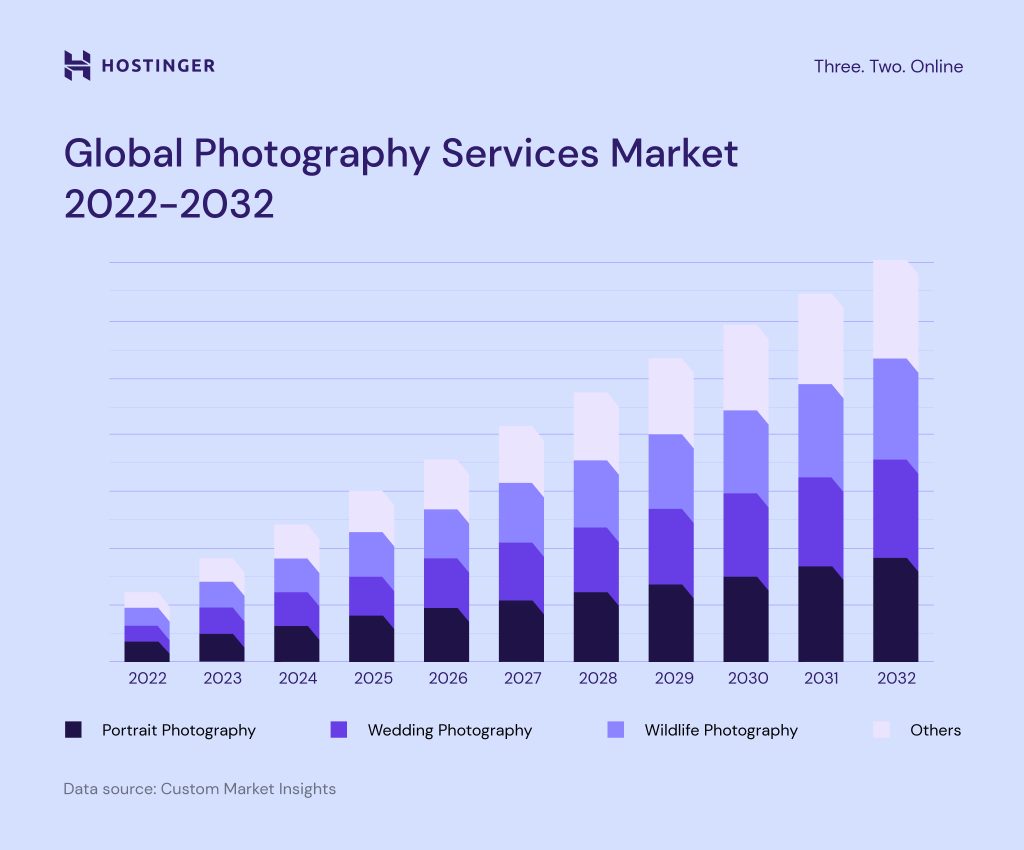
Expert Tip
For my photography business, I switched to weddings as they tend to be more profitable while still staying in the event photography sphere, which is my comfort zone. Weddings allow all that and pay, on average, 2.5 to 3 times more than working with other businesses. Wedding clients also tend to be a little less demanding, believe it or not!
3. Choose a business name & establish your brand identity
A memorable and relevant business name can benefit your marketing efforts. It also helps attract clients by making your brand easy to remember. Similar to brand identity, it should reflect your style as a photographer.
Here are some common photography business names to inspire you:
- Your full name, like “John Smith Photography,” to add a personal touch.
- Creative and unique names like “Captured Moments Photography” reflect specific photography styles.
- Location-based names like “Chicago Photography” help you connect with local clients.
- Your initials, like “KS Photography,” offer a simple yet elegant option.
- Words with a personal touch, such as “Everlasting Memories by Jane,” can create a heartfelt and distinctive brand.
Domain Name Checker
Instantly check domain name availability.
It’s important to test your name options with friends, family, and potential clients to get feedback. This step ensures that your chosen name resonates well with others and effectively reflects your brand.
Additionally, check the availability of your chosen name. Ensure it’s not already in use by another business to avoid legal issues and confusion. Securing the name for your domain and social media handles is also crucial for maintaining a cohesive brand identity online.
Start with a logo design. Create a logo that reflects your photography style and business values. It should be visually appealing and easily recognizable.
Next, choose your brand colors. Choose colors that evoke the right emotions and align with your photography type. For example, wedding photographers typically use bright and soft colors to convey romance and joy.

At the same time, portrait photographers often opt for black and white to highlight elegance and timelessness.
Then, select fonts that complement your overall brand aesthetic and are easy to read across different mediums. Browse Google Fonts’ library for inspiration and try to stick with one or two fonts for consistency.
Consistency is key when building a brand. Ensure that your logo, colors, and fonts are used uniformly across all your marketing materials, including your website, social media profiles, and business cards.
4. Write a business plan
A comprehensive business plan is essential to starting and growing your photography business. It provides a clear roadmap for your business and helps ensure you remain focused on your goals.
A well-crafted business plan is the foundation for making informed decisions, testing your niche, and aligning your business plans with your financial projections and startup costs.
Here are the key components of a business plan:
- Executive summary. A brief overview of your business, including your mission statement, core objectives, and what makes your business unique. It sets the stage for the rest of the plan.
- Market analysis. This section helps you determine the demand for your services and how to position yourself effectively based on your target audience, competitors, and market trends.
- Business structure. Outline your business’s legal structure, whether it’s a sole proprietorship, LLC, or corporation. Include details about ownership, roles, and responsibilities within your business.
- Services. Describe the range of services you will provide. If you focus on portrait photography or own a photo studio, describe your services, packages, and special deals.
- Financial projections. Outline your startup costs, such as equipment, marketing, and initial operational expenses. Project your revenue streams, considering different sources like session fees, prints, and digital downloads.
Adjust your business plan to fit your photography niche. For example, a pet photography business plan would target pet owners in the market analysis, providing themed photo sessions and outdoor shoots.
A photography studio business plan outlines studio setup, portrait and commercial sessions, local advertising, and social media marketing.
5. Register your business
Registering your photography business is crucial to ensure it operates legally and professionally. It also helps protect your personal assets and set a solid foundation for your business entity.
Here’s how to register your photography business:
- Register your business name. Once you choose a name, register it with your state or local government.
- Decide on the business structure. Choose between a sole proprietorship or a limited liability company (LLC). For most photographers, starting as a sole proprietor and later transitioning to an LLC is a practical path.
Expert Tip
I started as a sole proprietor and quickly changed to an LLC to protect my personal assets in case of any mishaps in the field. Forming an LLC in Connecticut took just over an hour online and cost just $200 in total.
- Obtain an Employee Identification Number (EIN). If you’re US-based, apply for an EIN through the IRS website. An EIN is essential for tax purposes and helps you open a business bank account.
- Acquire necessary business licenses and permits. Check with your local government to determine which licenses and permits are required for your photography business. Requirements vary by location.
- Get business insurance. Business insurance protects against any damages or accidents during a shoot. Public liability insurance is typically needed for photographers.
- Open a business bank account. It’s essential to keep business finances separate from personal ones. A business bank account helps you manage income and expenses effectively.
- Comply with tax regulations. Ensure you understand and comply with all tax regulations. This includes registering for sales tax and keeping accurate financial records. Doing so also helps collect sales tax for your photography services.
Registering your photography business legally might seem difficult, but it’s an important step to take your business forward and protect your photography work.
6. Choose the right equipment
Choosing the right equipment is a foundational step in starting your photography business. Having the appropriate gear can boost your work quality and efficiency. Start with the essential items:
- Cameras. Invest in a reliable camera that suits your photography style. Entry-level DSLRs or mirrorless cameras are excellent starting points.
- Lenses. A versatile lens, such as a 50mm prime or an 18-55mm zoom, is vital for various shooting scenarios. Over time, you can expand your collection based on your niche, such as wide-angle lenses for landscapes or macro lenses for close-up shots.
- Lighting. Start with essential tools like a portable flash or a continuous light source. As you grow, consider investing in a complete lighting setup, including softboxes, reflectors, and diffusers.
- Photo editing software. Software like Adobe Lightroom and Photoshop are industry standards. These tools help you refine and perfect your images, making your work professional.
Start small and build up your gear as you go. You can also rent equipment for specific shoots or try different tools before purchasing.
Expert Tip
Choosing equipment was a case of prioritizing versatility and sustainability. Trendy gadgets can be alluring, but we ended up investing in industry-standard cameras, lenses, and lighting: affordable but, most importantly, future-proof.
Alternatively, consider buying second-hand equipment to save money without compromising on quality. Many photographers upgrade their gear regularly so you can find well-maintained, high-quality cameras and lenses at a fraction of the cost.
Platforms like eBay, Craigslist, or dedicated photography forums are good places to start. Ensure you buy from reputable sellers and, if possible, test the equipment before purchasing.
7. Set your pricing
Start by exploring different pricing models, such as hourly rates, flat fees, and package deals. Each model has advantages, and the best choice depends on your business structure and your services.
To set profitable prices, you need to calculate your costs accurately. Consider all expenses, including equipment, software, and the time spent on each project. Knowing your costs ensures that your prices cover your expenses and provide a profit margin.
It’s also helpful to research competitor prices. Look at what other photographers in your area and niche are charging. This information helps you set competitive rates that attract clients while ensuring your business remains sustainable.
Review and adjust your prices regularly to reflect changes in costs, market demand, and the value you provide. Staying flexible ensures you remain competitive and profitable.
Expert Tip
I’d recommend starting small – and if you have a full-time job, hold on to it while you gather experience and a set of portfolio-worthy images. You should first figure out what it will cost you to run your business in a year. Then, figure out how much you will need to live comfortably after taxes and how many shoots you can expect to book in a year.
Finally, remember to factor in discounts and special offers. Strategic discounts for first-time clients, referrals, or off-peak seasons can attract more business without compromising your overall pricing strategy.
8. Create your photography website
Your website, or online portfolio, serves as a platform for showcasing your work and attracting clients. A strong photography website combines great design with easy navigation and showcases your best images in a visually appealing way.
To create your photography website, start by choosing the right platform. We recommend Hostinger Website Builder which offers the following features:
- AI builder to generate a unique website based on your photography business.
- Value for money with reliable hosting resources and a free domain name for the first year.
- An appointment booking system to schedule photoshoots and meetings with clients.
- SEO tools to help your website rank higher on search engines.
- Built-in control panel to manage your website and hosting account.
- Responsive, designer-made templates suitable for your photography business.
Expert Tip
It’s so easy to design the exact website you’re after, and you don’t have to be a website guru to create a great website! My favorite feature of Hostinger is that I can see every contact submission in my emails and on the website, so I don’t lose track of potential clients!
Currently, there are two pricing plans – Premium Website Builder and Business Website Builder.
We recommend choosing the Business Website Builder plan because it includes the appointment booking feature and online store functionality. With this plan, you can also schedule client sessions and sell prints or digital downloads of your photography. The plan is $3.99/month.
Use the AI builder
For this article, we’ll use the AI Website Builder to create the website.

Click Start creating button and fill out your business details. This includes website type, brand name, and description. Also, include your preferred colors and fonts for the website.
Below is an example of how to add your details. For your photography business, choose Online store as the website type. For description, be as detailed as possible so AI can create a better website.

Click Create a website once you’re ready, and AI will start generating the website. Once done, the website will have all the essential pages: Home, Shop, Portfolio, and Contact.
You can start customizing the website by clicking the Edit button on the top right corner.
After that, the website setup flow will take you to the online store creation.
Set up your store
On the online store setup page, you can add your country and currency. Once done, you’ll be directed to the Store manager dashboard. Continue the store setup process by going through the checklist.

Add products
Still on the store setup checklist page, you can add your first product. Click Add product and choose between Service or Appointment for clients to book your photography services.
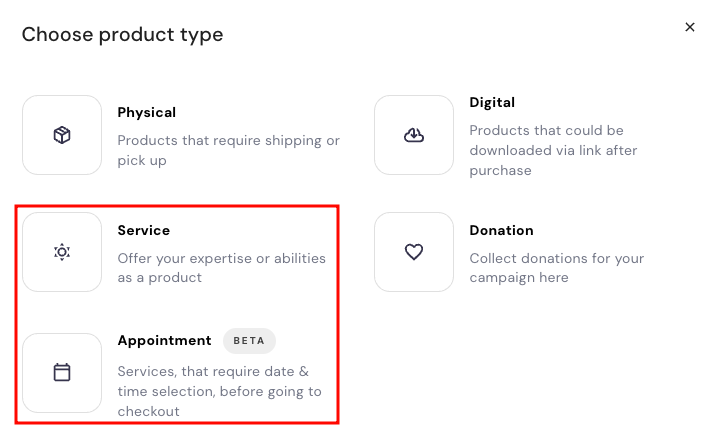
We recommend choosing Appointment so you can schedule photo sessions easily. Enable the appointment feature, then start adding your details. Once you’re done, click Save.
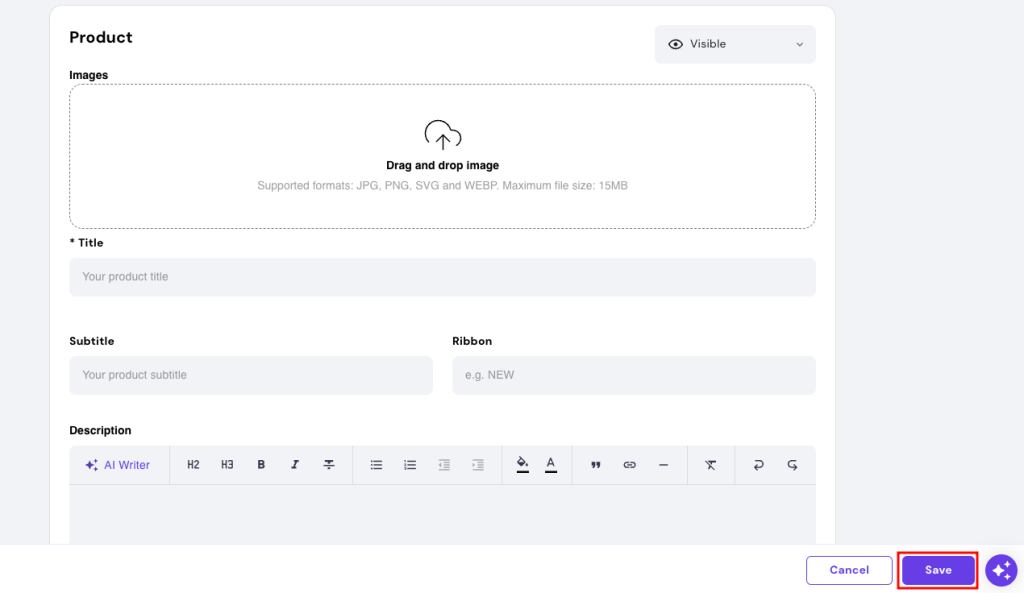
Set up a payment method
Connect your website with various payment gateways, so your clients can easily pay for their sessions online. Consider PayPal and Stripe as your main options. For businesses in LATAM countries, we recommend using dLocal Go.
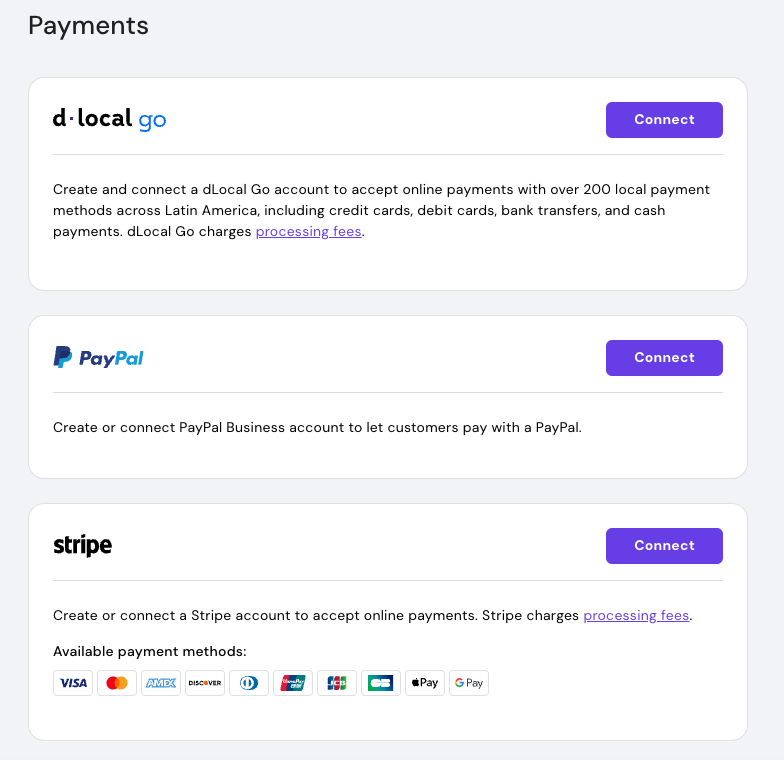
Add business information
The next step is to add your business name, logo, contact details, and address. Simply fill out all the required information and save your progress.
Once the online store is set up, click Edit website to start customizing the rest of the site.
Personalize your website design
On the editor page, you can adjust colors, fonts, and style to align it better with your branding.
For website design inspiration, check out our photography website examples built with Hostinger Website Builder. The list ranges from fashion to wedding photographers with various layouts and color palettes.
Upload your photography work
Your website isn’t complete without a photography portfolio page. On the site editor page, go to the Portfolio page to start uploading photos. Click on an existing photo → Edit image → Replace image. This will open your media library, where you can upload your photos.
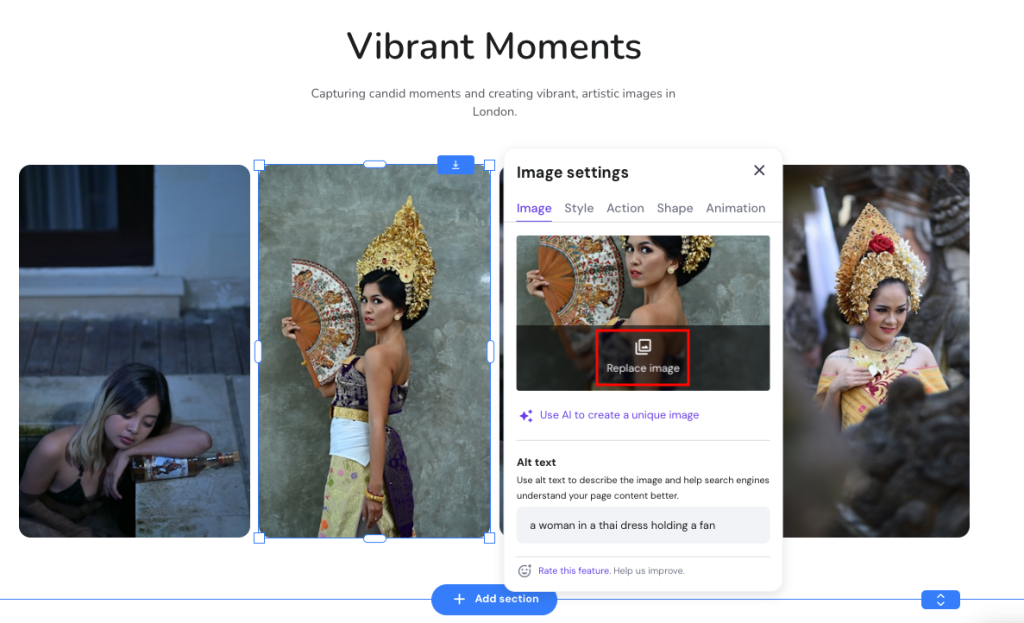
Additionally, you can add a photo gallery to your portfolio page. Go to the section where you want the gallery to be, then click Add section.
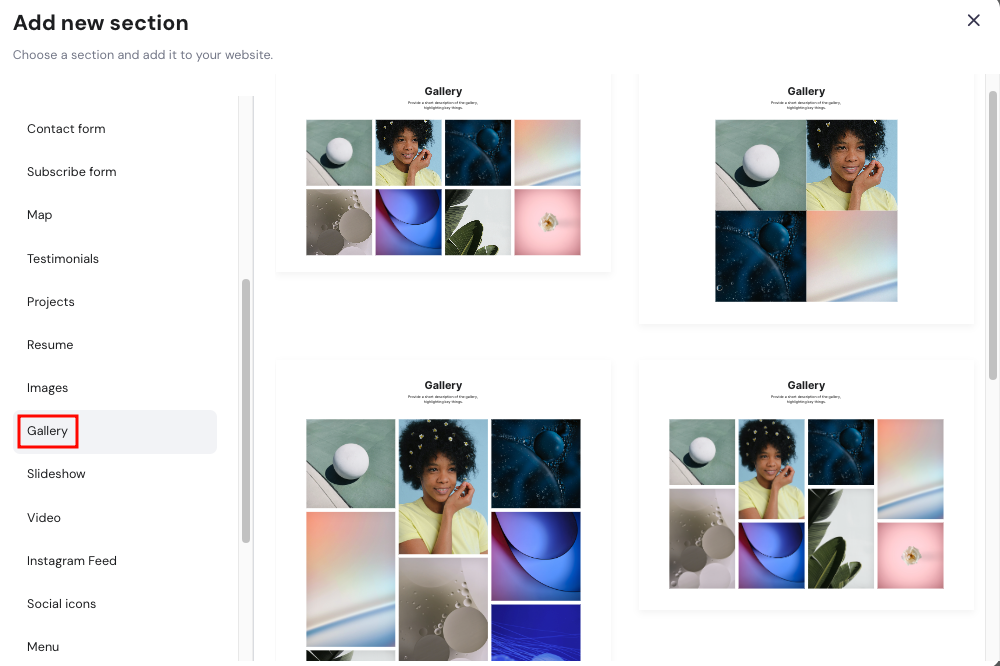
Choose your preferred gallery layout, and click Edit gallery to open the gallery settings page. Here, you can adjust items per row, the gap between photos, and more.
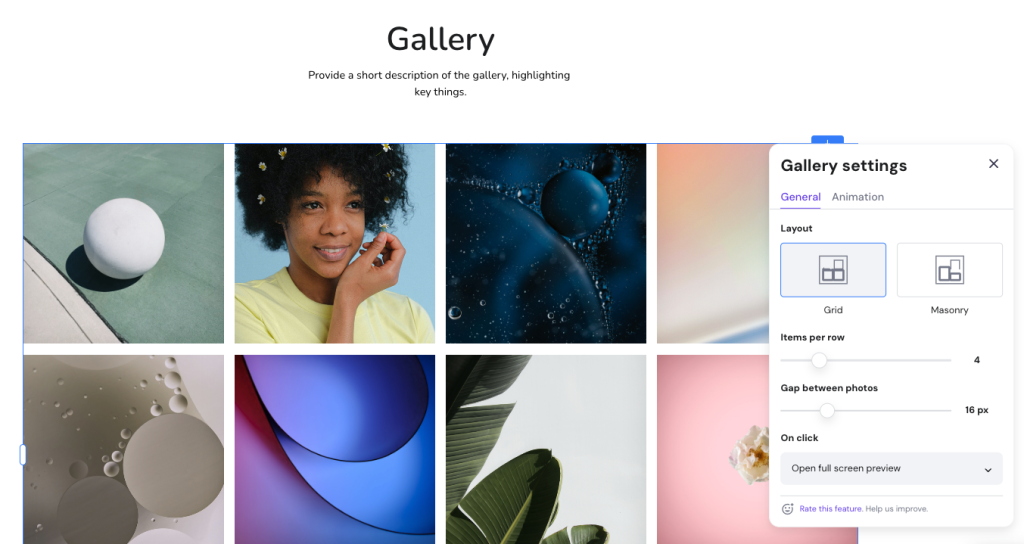
Publish the website
Before clicking the Publish button, ensure all pages are complete and ready for visitors. Additionally, start tapping into search engine optimization (SEO) strategies. SEO helps your website rank higher in search engine results, making it easier for potential clients to find you.
Consider setting up Google Analytics to track your website’s performance and gather insights on visitor behavior. You can integrate your Google Analytics account by going to Website settings → Integrations page.
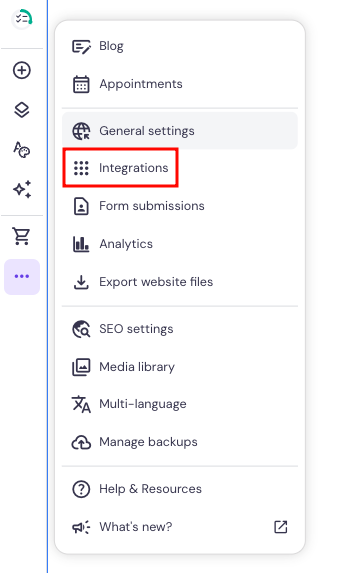
Suggested Reading
For a more comprehensive guide, check out our article on making a photography website.
9. Promote your business
Promoting your photography business effectively helps attract potential clients and builds a strong presence. Social media can be used as a platform to showcase your work and engage with potential clients.
Start by creating profiles on some of the most popular social media platforms: Facebook, YouTube, Instagram, and TikTok. Each platform comes with a unique setup you can use to share photos, interact with followers, and promote your services.
Facebook can provide a more in-depth view of your business. Use this platform to share longer posts and albums of your work, as well as engage in photoshoots with potential clients through comments and messages.
YouTube is a great platform for sharing behind-the-scenes videos, tutorials, and client testimonials. This can give viewers a closer look at your work and help them better understand your style. Take inspiration from Peter McKinnon’s channel, which has over 5 million subscribers.

Instagram is all about visual content, making it the perfect place to showcase your photography skills. Use hashtags relevant to your niche and engage with other users by liking and commenting on their posts.
TikTok has quickly become a popular platform for businesses to promote themselves. With its short-form video format, you can create quick, eye-catching previews of your work that will capture the attention of potential clients.
10. Build a network of clients
A solid network of satisfied clients ensures a steady stream of work and helps establish your reputation in the industry.
Start by focusing on exceeding client expectations with every project. Deliver high-quality work, meet deadlines, and provide excellent customer service. Going the extra mile for your clients fosters word-of-mouth referrals.
Additionally, don’t be shy about asking for testimonials and online reviews. Positive feedback from happy clients enhances your credibility and can significantly attract new clients.
Encourage clients to leave reviews directly on your website and via platforms like Google Maps reviews. These reviews are powerful endorsements, making your business more visible to potential customers. Below is Tilly Rose’s review as a wedding photographer.
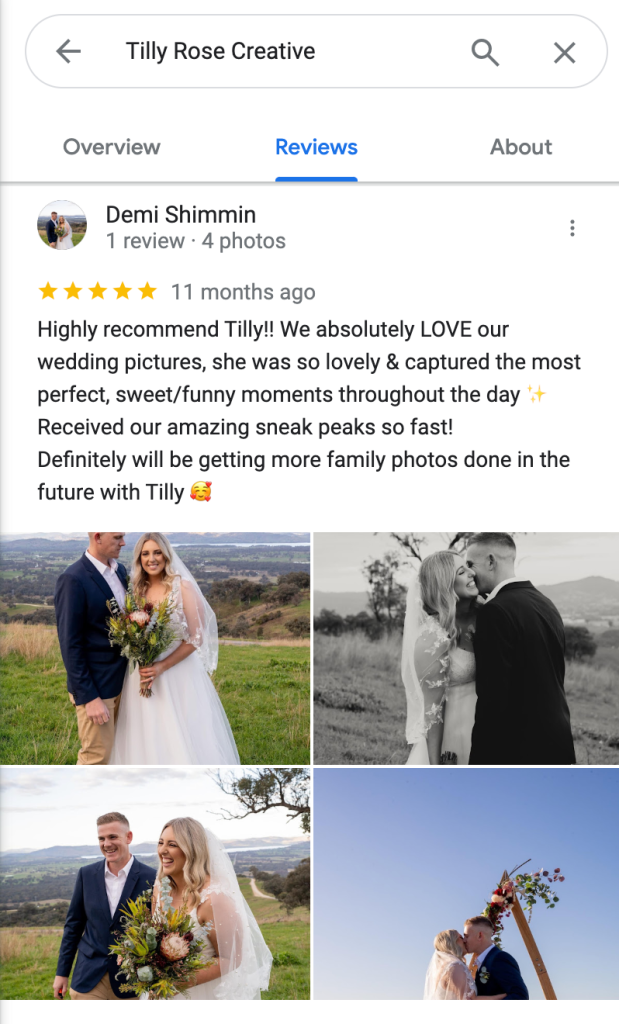
Conclusion
The key to a successful photography business lies in thorough preparation and strategic execution.
Remember, every professional photographer started somewhere, facing similar challenges and uncertainties. Stay persistent, keep learning, and continually refine your craft. With dedication and the right approach, you can turn your passion for photography into a successful business.
Download checklist: How to start an online business
How to start a photography business FAQ
Is a photography business profitable?
Absolutely! A photography business can be profitable with the right marketing strategy, competitive pricing, and top-notch services. Your success often hinges on finding your niche and managing your business effectively.
How much does it cost to start a photography business?
The cost can vary widely based on your specific needs and goals. The key is to be smart about your budget. Prioritize essential equipment, use platforms like Hostinger Website Builder, buy second-hand gear, and leverage free social media marketing.
Should a photographer be an LLC?
Yes, forming an LLC is a smart move for photographers. It offers liability protection, keeps your personal and business finances separate, and can provide tax benefits. Always consult a legal professional for advice tailored to your situation.







